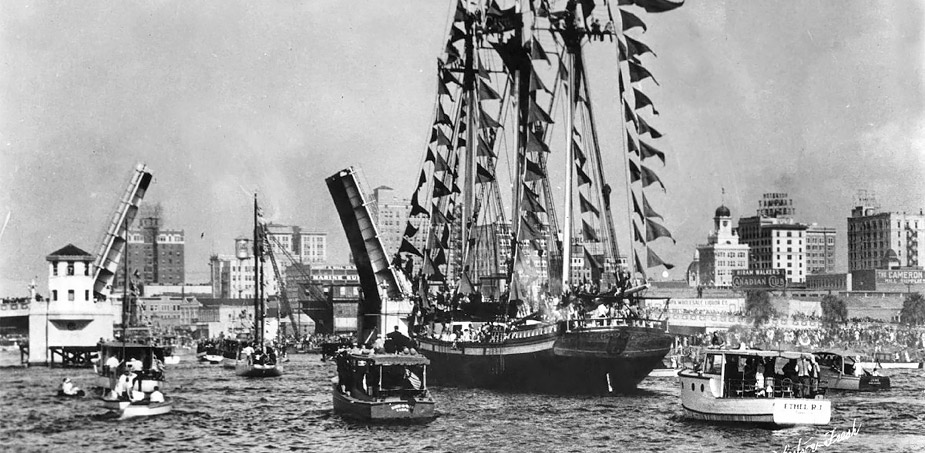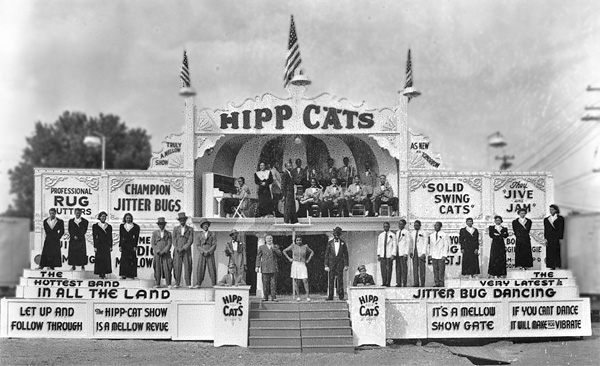


The Gasparilla invasion, 1938
The schooner William Bisbee as the Jose Gaspar and accompanying flotilla approaches the Platt Street bridge at
the mouth of the Hillsborough River.
Robertson
& Fresh photo courtesy of USF
|
TAMPA AGAIN MOVES FORWARD - Late 30s / early 40s Sometime during the mid-Thirties, no on knows exactly when, the United States passed through the crisis of the Great Depression. Strangely enough, the change for the better came even before WPA rolls had reached their peak. But the psychology of the nation changed, and people began looking toward the future with renewed confidence. The improvement throughout the country benefitted South Florida. Each winter the number of tourists showed an increase, and the visitors spent more money than they had before. Merchants did better business, bank deposits started climbing, and the construction industry came to life again. During 1938 there was a setback. That was the year of the national recession. But then in 1939, came the only infallible remedy ever discovered by man for the cure of recessions and depressions—war. On September 1, 1939, Germany invaded Poland and two days later, World War II had begun. The clash of the armies, the bursting of bombs, and the roar of the cannons in Europe brought prosperity back to the United States, and to Tampa. Almost immediately, the Tampa Shipbuilding Company, which had leased its yards to the Oscar Daniels Company during World War I, received a contract from the government for four 10,000 ton steel ships to cost about $2 million each. The company, headed by Ernest Kreher, had borrowed $750,000 from the WPA to build a 10,000 ton dry dock a short time before, after it had become apparent that war in Europe was inevitable. The shipyards had been enlarged and re-tooled and the company was all set to swing into action. Before the end of 1939, the company employed more than 2,000 men and had started work on the first two ships, the Seawitch and the Shooting Star. The yards hummed with activity. During the late summer of 1940, the company got into financial difficulties and in November, the Tampa Shipbuilding Company organized to take over operations with George B. Howell as president and J. W. Gray as secretary and treasurer. Kreher remained with the company as consulting engineer. Thereafter, ship after ship slipped off the ways in Ybor Channel to join the fleets carrying supplies to war-torn Europe. When the U.S. entered the conflict, operations were speeded up still more. Employment reached a peak of 16,000. Nearly a hundred ships were constructed, principally for the Navy. The largest were the destroyer tenders Piedmont, Sierra and Yosemite, which cost $17 million each. The company also repaired and converted more than 500 other ships, including many which had been damaged by submarines or in battles. The company’s operations were undoubtedly the largest ever conducted in South Florida. More than $8 million was spent in additional plant buildings, tools and machinery, and to handle the tremendous volume of materials pouring into the city, the company leased sixteen warehouses. Its weekly payroll at peak production exceeded $750,000. To satisfy the nation’s insatiable appetite for ships, another shipbuilding company was established in Tampa—McCloskey & Company, which had its yards and shops at Hooker’s Point. This company built 5,000-ton concrete ships and at the peak employed 4,000 men. Its shops were equipped with more than a million dollars worth of machinery and it owned a huge graving dry dock capable of accommodating a 480-foot vessel. Seventy-eight large sea-going tugs were also built in Tampa for the army, by the Tampa Marine Corporation. A the peak, the company had 2,300 employees. It was awarded the Army-Navy “E” on April 18, 1944—the first given to a Tampa company. Tampa Gets an Air Base Less than three months after the beginning of World War II in 1939, work started on a project which has meant more to Tampa than anything since the coming of Plant’s railroad in 1884—MacDill Field. See: History of MacDill Field at Tampapix Clearing the land for the base, construction of the buildings, hangars and runways, and the extending of Lisbon Avenue (later renamed MacDill Ave.) were the last WPA projects in Hillsborough County. When they started, more than 8,000 workers were on WPA rolls. By the time the U.S. entered the war, WPA had faded out of the pictures. Soon there was a shortage of workers in Tampa instead of an unemployment problem. |
|
|
|
|
|
|
|
|
|
|
|
|
|
|
|
|
Goody Goody Drive-In Restaurant, 1941 |
|
|
The Hipp Cats and champion Jitterbuggers, 1941 The Hipp Cats
recorded "It Must Be Jelly" ('Cause Jam Don't Shake Like That) in 1939.
|
 |
Page1 | Page2 | Page3 | Page4 | Page5 | Page6 | Page7 | Page8 | Tampapix Home